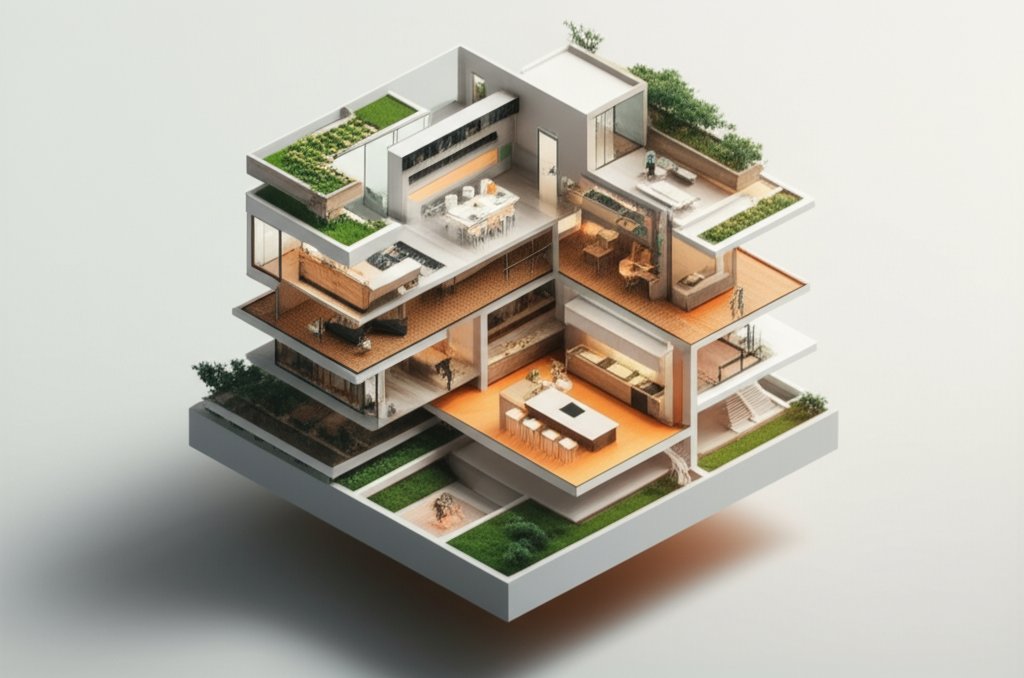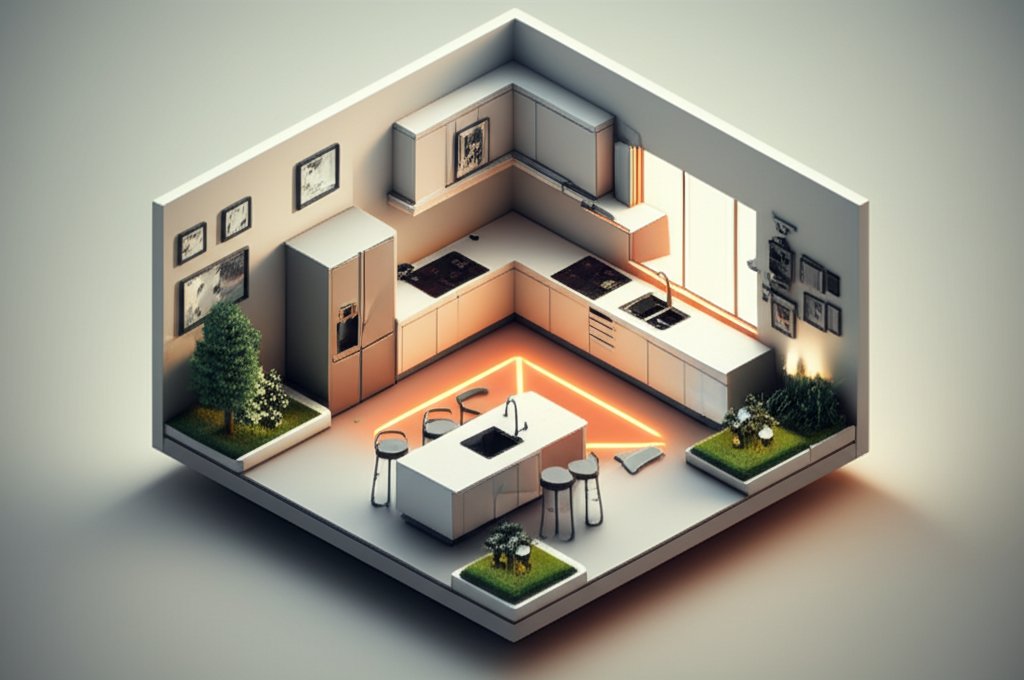Stuck dreaming about a spacious, functional kitchen but overwhelmed by the endless layout options? Designing innovative kitchen floor plans with island features requires careful consideration of space, workflow, and your lifestyle. It’s about making the heart of your home both beautiful and efficient.
At a glance:
- Discover the most popular kitchen floor plan layouts for islands, from L-shaped to galley designs.
- Learn how to optimize your work triangle for seamless meal prep and cooking.
- Get practical tips for maximizing storage in your island and throughout the kitchen.
- Understand critical dimensions for island placement and aisle widths.
- Find out how to choose the right island size and shape for your space and needs.
Decoding the Most Popular Kitchen Floor Plans With Island
Choosing the right floor plan is foundational. Different layouts offer unique advantages depending on the size and shape of your kitchen, as well as your priorities. Let’s explore these popular options and when each shines.
L-Shaped Kitchens: Balancing Space and Sociability
An L-shaped kitchen utilizes two perpendicular walls, maximizing corner space and creating an open feel. Integrating an island into this design provides additional counter space, storage, and seating.
- Benefits: Efficient workflow, ample workspace, and a social hub.
- Ideal for: Medium-sized kitchens that want to maintain an open connection to adjacent living areas.
- Considerations: Ensure sufficient space between the island and countertops (at least 42 inches) for comfortable movement.
- Example: A 12′ x 14′ L-shaped kitchen can comfortably accommodate an island with seating for two to three people.
U-Shaped Kitchens: Wrap-Around Efficiency
U-shaped kitchens surround the cook on three sides, offering maximum counter and storage space within easy reach. An island in a U-shaped kitchen further enhances functionality and can serve as a central gathering spot.
- Benefits: Highly efficient work triangle, additional prep space, and social integration.
- Ideal for: Small to medium-sized kitchens where maximizing storage and workspace is crucial.
- Considerations: Carefully plan the island’s placement to avoid blocking pathways and to maintain an open feel.
- Example: A 14′ x 16′ U-shaped kitchen can incorporate an island with a built-in sink or cooktop for added convenience.
Galley Kitchens: Streamlined and Compact
Galley kitchens feature two parallel runs of cabinets and appliances, creating a narrow and efficient workspace. Adding a low-profile island (or peninsula) to a galley kitchen can significantly improve functionality and create a connection to the adjacent living space.
- Benefits: Space efficiency, streamlined workflow, and potential for social interaction.
- Ideal for: Small apartments or homes where space is limited.
- Considerations: Choose a narrow island (around 36 inches wide) to maintain adequate aisle space. Consider a rolling island cart for added flexibility.
- Example: A 12′ x 10′ galley kitchen can benefit from a slim island that provides extra counter space and seating without cramping the room.
One-Wall Kitchens: Simple and Versatile
A one-wall kitchen consolidates all appliances and cabinets along a single wall, making it an ideal choice for smaller spaces or open-concept layouts. Adding an island to this design creates a focal point and expands functionality.
- Benefits: Space efficiency, additional workspace, and social integration.
- Ideal for: Apartments, condos, or homes with open floor plans where the kitchen is integrated into the living area.
- Considerations: The island can be used as a breakfast bar, a prep area, or a serving station. Optimize storage within the island to compensate for limited wall cabinets.
- Example: A 12’ x 14’ one-wall kitchen benefits from a large island with built-in storage and seating, transforming the space into a versatile hub.
Double Island Kitchens: The Ultimate in Functionality
For larger kitchens and households that love to cook and entertain, a double island kitchen offers unparalleled workspace, storage, and social interaction.
- Benefits: Efficient workflow, social hub, and ample workspace.
- Ideal for: Large homes with a dedicated kitchen space and a desire for multiple cooking zones.
- Considerations: Plan for adequate aisle space (48 inches or more) between the islands and surrounding countertops. Designate specific functions for each island (e.g., prep, serving, dining).
- Example: A 16’ x 20’ double island kitchen can have one island dedicated to food preparation with a sink and ample counter space, and the other island serving as a gathering spot with seating and a beverage center.
If you’re eager to explore more open-concept designs, Here are a few options, depending on the surrounding content: * Explore open concept kitchen plans. * Design ideas: island kitchens. * Open kitchen designs with islands. * More island kitchen design inspiration..
Mastering the Kitchen Work Triangle in Your Island Design
The “work triangle” concept remains a valuable tool for optimizing kitchen efficiency. It emphasizes the relationship between the sink, stove, and refrigerator; The distances between these zones should be no less than 4 feet and no more than 9 feet, and the sum of all three sides of the triangle should be from 13 feet to 26 feet. An island can either enhance or disrupt this triangle, so careful planning is essential.
- Enhancing the Triangle: Place a sink or cooktop in the island to bring one of the work zones closer to the others.
- Avoiding Disruption: Ensure the island doesn’t block direct access between the three primary work zones.
- Example: In an L-shaped kitchen, placing the sink on the island can create a more compact and efficient work triangle.
Smart Storage Solutions for Your Kitchen Island

An island’s value extends beyond its countertop space; it’s an opportunity to maximize storage. Consider these options:
- Drawers: Ideal for pots, pans, and utensils.
- Cabinets: Perfect for storing larger items like small appliances or cookbooks.
- Pull-out shelves: Great for maximizing accessibility to hard-to-reach items.
- Open shelving: Adds visual interest and provides easy access to frequently used items.
- Wine racks: A stylish and functional addition for wine enthusiasts.
- Hidden trash/recycling bins: Keeps your kitchen clean and organized.
- Example: Incorporating a pull-out spice rack in the island keeps countertops clutter-free.
Critical Dimensions for Island Placement and Aisle Widths
Proper spacing is crucial for a functional and comfortable kitchen. Pay close attention to these dimensions:
- Aisle Width: A minimum of 42 inches is recommended for walkways around the island. For kitchens with multiple cooks, 48 inches is preferable.
- Island Height: Standard countertop height is 36 inches. For a breakfast bar, a height of 42 inches is recommended.
- Seating Overhang: A minimum of 12 inches of overhang is needed for comfortable seating.
- Example: In a 12’x12′ kitchen with a portable island, make sure the walkways around the island are a minimum of 42 inches wide to provide enough room for movement.
Choosing the Right Island Size and Shape

The ideal island size and shape depend on your kitchen’s dimensions and your specific needs. Here’s a quick guide:
- Small Kitchens: Opt for a smaller island or a rolling cart to maximize space.
- Large Kitchens: Consider a larger island with multiple features, such as a sink, cooktop, and seating.
- Rectangular Islands: The most common shape, providing ample counter space and storage.
- Square Islands: Work well in square kitchens, creating a focal point and providing a central workspace.
- Round or Oval Islands: Soften the lines of a rectangular kitchen and create a more social atmosphere.
- Example: A 10′ x 15′ kitchen would work well with a central island that doubles as extra prep space and a dining area for two.
Practical Playbook: Implementing Your Island Design
Ready to put these ideas into practice? Here’s a step-by-step guide:
- Measure Your Kitchen: Accurate measurements are essential for planning your island layout.
- Determine Your Priorities: Decide what functions you want your island to serve (e.g., prep, cooking, seating, storage).
- Choose a Layout: Select the floor plan that best suits your kitchen’s dimensions and your needs.
- Plan Your Island’s Features: Incorporate storage solutions, appliances, and seating based on your priorities.
- Consider Materials and Finishes: Choose materials that complement your existing kitchen design and reflect your personal style.
- Consult with a Professional: A kitchen designer or contractor can help you refine your plans and ensure a successful installation.
Quick Answers: FAQs on Kitchen Floor Plans with Island
Q: How big should my kitchen island be?
A: The size depends on your kitchen’s overall dimensions and needs. A good starting point is to aim for an island that’s approximately one-third the length of your kitchen. Remember to leave at least 42 inches of clearance around the island.
Q: Can I put a cooktop in my island?
A: Yes, but you’ll need to ensure proper ventilation and electrical or gas connections. Consider a downdraft vent or a range hood that hangs from the ceiling.
Q: What’s the best material for a kitchen island countertop?
A: Popular choices include granite, quartz, wood, and stainless steel. Granite is durable and heat-resistant, while quartz is non-porous and easy to maintain. Wood adds warmth and character, and stainless steel provides a sleek and modern look.
Q: How high should bar stools be for a kitchen island?
A: For a standard 42-inch high breakfast bar, stools with a seat height of 28-30 inches inches are ideal. Ensure there’s enough legroom.
Your Actionable Close: Bringing Your Island Dream to Life
Designing kitchen floor plans with island features requires thoughtful planning and attention to detail. By understanding the different layout options, optimizing your work triangle, maximizing storage, and choosing the right island size and shape, you can create a kitchen that’s both functional and beautiful. Start by measuring your space, prioritizing your needs, and consulting with a professional to bring your vision to life. A well-designed kitchen island can transform your space into the heart of your home, where cooking, gathering, and creating memories become a joy.
- Gray Kitchen Backsplash Tile: Ideas for a Stylish Upgrade - December 14, 2025
- Backsplash For Gray Cabinets: Choosing the Right Backsplash Style - December 13, 2025
- Gray And White Backsplash: Ideas For Timeless Style - December 12, 2025









